In the News:
July 2012 was hottest on record
July 2012 was the hottest month on record for the lower 48 States, according to recent analysis by the National Oceanic and Atmospheric Administration (NOAA). Temperatures in the contiguous U.S. averaged 77.6 degrees in July, 3.3 degrees warmer than the 20th century average for the month. The previous warmest July was in 1936, when temperatures averaged 77.4 degrees. The largest deviations from normal were in states in the Midwest and Plains areas.
The hot weather led to increases in natural gas consumption for power generation to meet air conditioning demand, particularly in areas that rely heavily on natural gas-fired power. Total natural gas consumed in power generation in July averaged 35.06 billion cubic feet (Bcf) per day, according to data released by BENTEK Energy LLC (Bentek), an increase of 4.42 Bcf per day (14.4 percent) from July 2011 (July 2011 averaged 77.0 degrees nationwide). Some of the year-over-year increase is due to changes in infrastructure and cost advantages of natural gas over coal. Natural gas power burn in the Midwest increased 1.20 Bcf per day from the previous year, from 2.18 Bcf per day to 3.38 Bcf per day, and power burn in the Southeast increased from 8.81 Bcf per day to 10.90 Bcf per day, according to Bentek estimates.
Overview:
(For the Week Ending Wednesday, August 15, 2012)
- Natural gas prices generally registered overall decreases for the report week (Wednesday to Wednesday) at many of the country's trading locations. The Henry Hub price, which had fallen 19 cents per million British thermal units (MMBtu) by Monday's close, increased relatively modestly on Tuesday and Wednesday to close at $2.82 per MMBtu down 14 cents for the week.
- The natural gas futures market dropped sharply after a modest increase earlier in the reporting week, then rebounded toward the end of the week. At the New York Mercantile Exchange (NYMEX), the September 2012 natural gas contract lost 18.5 cents per MMBtu to close at $2.748 per MMBtu yesterday.
- Working natural gas in storage rose last week to 3,261 Bcf as of Friday, August 10, according to the U.S. Energy Information Administration's (EIA) Weekly Natural Gas Storage Report (WNGSR). An implied storage build of 20 Bcf for the week positioned storage volumes 442 Bcf above year-ago levels.
- The natural gas rotary rig count, as reported by Baker Hughes Incorporated on August 10, declined by 3 to 495 active units. Meanwhile, oil-directed rigs increased by 3 to 1,432 units.
Prices:
The Henry Hub day-ahead price registered an overall decrease for the week, declining sharply through Monday before regaining some ground on Tuesday and Wednesday, closing the week at $2.82 per MMBtu, down 4.7 percent. In the Midwest, cooler-than-normal temperatures dampened prices over much of the reporting week, after which a return to warmer weather helped generate modest increases in end-of-week prices. The Chicago Citygate price, for example, fell 15 cents per MMBtu from Wednesday to Monday before rebounding 3 cents, closing the week at $2.87 per MMBtu.
At the NYMEX, the September 2012 contract ended the week lower, declining from $2.933 per MMBtu last Wednesday to $2.748 per MMBtu yesterday, an overall decrease of 6.3 percent. Prices rose slightly on Thursday, reflecting, in part, a temporary return to above-normal temperatures for several parts of the nation. Prices declined on Friday and Monday before jumping nearly 11 cents per MMBtu on Tuesday and then shedding nearly all of that gain yesterday. The 12-Month Strip (average of September 2012 to August 2013 contracts) declined over much of the reporting week, closing at $3.283 per MMBtu, down 15.3 cents per MMBtu (4.5 percent) for the week.
Prices at many downstream trading locations recorded overall decreases, falling on Thursday and Friday before increasing moderately toward the end of the week. In the Northeast, certain locations saw prices drop considerably before regaining ground by week's end. For example, at the Algonquin Citygate trading point (for delivery into Boston), spot prices started the reporting week at $4.24 per MMBtu, fell to $3.44 per MMBtu on Friday as temperatures dipped toward normal, then rose steadily behind a return to warmer weather to close yesterday at $3.81 per MMBtu (down 10.1 percent for the week). While prices in Southern California also declined, the overall drop was relatively muted due in part to persistently higher-than-average temperatures throughout the week. The Southern California Border Average price dropped from $3.11 per MMBtu last Wednesday to $3.02 per MMBtu on Monday, then rose modestly to $3.03 per MMBtu by week's end (down 2.6 percent).
Total consumption for the report week registered an overall decrease, with higher residential/commercial and industrial sector demand being offset by a decrease in the power sector. According to estimates from Bentek, domestic natural gas consumption declined by 2.7 percent from last week, driven by a decrease of 6.8 percent in power sector consumption. Residential/commercial sector consumption ended the week up 6.2 percent, while industrial sector consumption was relatively unchanged (up 0.9 percent). Although down week-over-week, power sector consumption exceeded levels for the same week last year by 19.2 percent.
Total supply for the week was essentially unchanged, registering an overall decrease of 0.4 percent, reflecting relatively flat dry gas production. According to Bentek estimates, domestic weekly dry gas production was only 0.1 percent higher than the previous week (although 2.4 percent above the same time last year). Imports from Canada dropped by 4.4 percent, as declines in shipments to the Northeast and Midwest offset modest increases in the West. For the week, imports from Canada stand 5.6 percent above year-ago volumes. Liquefied natural gas (LNG) sendout dropped sharply, down 26.6 percent from last week; sendout volumes remain well below (36.0 percent) year-ago levels.
Storage
Working natural gas in storage increased to 3,261 Bcf as of Friday, August 10, according to EIA's WNGSR. This represents an implied net injection of 20 Bcf from the previous week. This week's injection was 23 Bcf below the 5-year (2007-2011) average injection of 43 Bcf, and 23 Bcf below last year's injection of 43 Bcf. Since April 27, injections of working natural gas into underground storage have fallen short of both year-ago levels and the 5-year average, although stocks remain well above historical levels. Inventories are currently 442 Bcf (15.7 percent) greater than last year at this time and 363 Bcf (12.5 percent) greater than the 5-year average.
One of the three storage regions posted an increase this week. Inventories in the East region increased by 29 Bcf (the 5-year average net injection is 45 Bcf). The West and Producing regions posted decreases of 5 Bcf (the 5-year average net injection is 5 Bcf) and 4 Bcf (the 5-year average net withdrawal is 7 Bcf), respectively. In the Producing Region, working natural gas inventories decreased 6 Bcf (2.6 percent) in salt cavern facilities and increased 2 Bcf (0.2 percent) in nonsalt cavern facilities.
Temperatures during the storage report week were 3.1 degrees warmer than the 30-year normal temperature and 0.4 degrees warmer than the same period last year. Temperatures in the lower 48 States averaged 78.1 degrees, compared to 77.7 last year and the 30-year normal of 75.0. During the week all regions were warmer than normal, particularly the New England and Middle Atlantic Census divisions in the Northeast, which, respectively, averaged 4.3 and 4.0 degrees warmer than the 30-year normal. In the West, temperatures in the Mountain Census division averaged 4.0 degrees warmer than the 30-year normal.
See also:
July 2012 Temperatures, Deviation from Normal
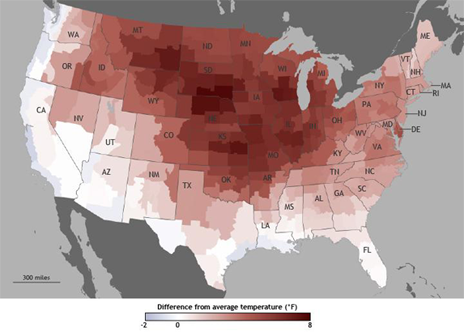
Source: National Oceanic and Atmospheric Administration
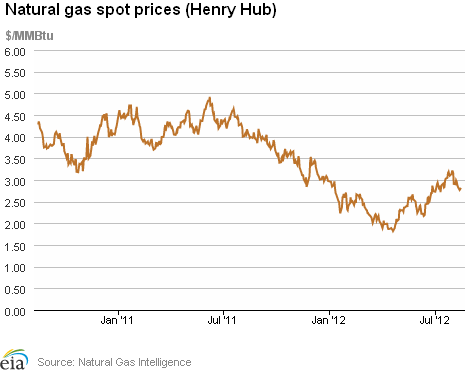
| Spot Prices ($/MMBtu) | Thu, 09-Aug |
Fri, 10-Aug |
Mon, 13-Aug |
Tue, 14-Aug |
Wed, 15-Aug |
|---|---|---|---|---|---|
| Henry Hub | 2.89 |
2.84 |
2.77 |
2.79 |
2.82 |
| New York | 3.10 |
3.00 |
2.98 |
2.97 |
2.98 |
| Chicago | 2.94 |
2.89 |
2.84 |
2.85 |
2.87 |
| Cal. Comp. Avg,* | 3.00 |
2.98 |
2.93 |
2.91 |
2.94 |
| Futures ($/MMBtu) | |||||
| September Contract | 2.945 |
2.770 |
2.729 |
2.834 |
2.748 |
| October Contract | 2.970 |
2.808 |
2.768 |
2.871 |
2.787 |
| *Avg. of NGI's reported prices for: Malin, PG&E citygate, and Southern California Border Avg. | |||||
| Source: NGI's Daily Gas Price Index | |||||
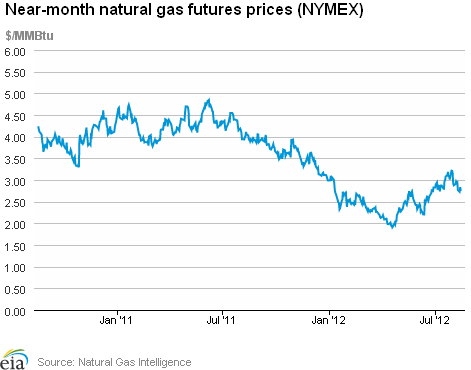
| U.S. Natural Gas Supply - Gas Week: (8/8/12 - 8/15/12) | ||
|---|---|---|
Percent change for week compared with: |
||
last year |
last week |
|
| Gross Production | 2.42%
|
0.12%
|
| Dry Production | 2.43%
|
0.12%
|
| Canadian Imports | 5.58%
|
-4.43%
|
| West (Net) | 24.47%
|
0.48%
|
| MidWest (Net) | -14.45%
|
-10.48%
|
| Northeast (Net) | 13.60%
|
-4.05%
|
| LNG Imports | -36.03%
|
-26.65%
|
| Total Supply | 2.50%
|
-0.40%
|
| Source: BENTEK Energy LLC | ||
| U.S. Consumption - Gas Week: (8/8/12 - 8/15/12) | ||
|---|---|---|
Percent change for week compared with: |
||
last year |
last week |
|
| U.S. Consumption | 11.12%
|
-2.74%
|
| Power | 19.21%
|
-6.79%
|
| Industrial | 1.73%
|
0.86%
|
| Residential/Commercial | 4.23%
|
6.20%
|
| Total Demand | 11.73%
|
-2.43%
|
| Source: BENTEK Energy LLC | ||
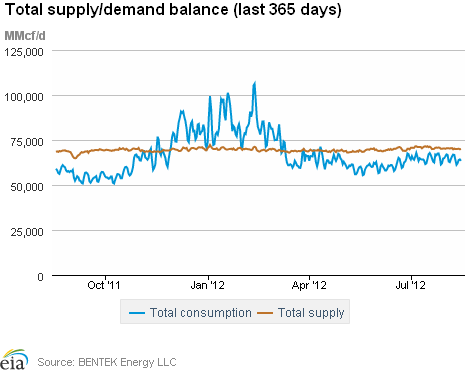
Weekly natural gas rig count and spot Henry Hub
active rigs$ per MMBtu
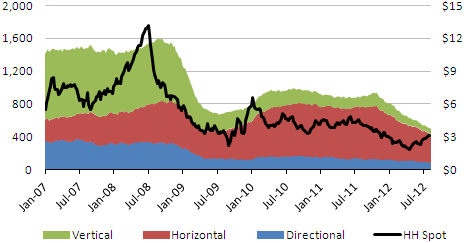
Source: Baker Hughes
| Rigs | |||
|---|---|---|---|
Fri, August 10, 2012 |
Change from |
||
last week |
last year |
||
| Oil Rigs | 1,432 |
0.21% |
35.73% |
| Natural Gas Rigs | 495 |
-0.60% |
-44.75% |
| Miscellaneous | 4 |
33.33% |
-50.00% |
| Rig Numbers by Type | |||
|---|---|---|---|
Fri, August 10, 2012 |
Change from |
||
last week |
last year |
||
| Vertical | 543 |
-0.73% |
-8.89% |
| Horizontal | 1,161 |
0.52% |
3.38% |
| Directional | 227 |
-0.44% |
-5.42% |
| Source: Baker Hughes Inc. | |||
| Working Gas in Underground Storage | ||||
|---|---|---|---|---|
Stocks billion cubic feet (bcf) |
||||
| Region | 8/10/12
|
8/3/12
|
change |
|
| East | 1,664 |
1,635 |
29
|
|
| West | 493 |
498 |
-5
|
|
| Producing | 1,104 |
1,108 |
-4
|
|
| Total | 3,261 |
3,241 |
20
|
|
| Source: U.S. Energy Information Administration | ||||
| Working Gas in Underground Storage | |||||
|---|---|---|---|---|---|
Historical Comparisons |
|||||
Year ago (8/10/11) |
5-year average (2007-2011) |
||||
| Region | Stocks (Bcf) |
% change |
Stocks (Bcf) |
% change |
|
| East | 1,452 |
14.6 |
1,546 |
7.6 |
|
| West | 411 |
20.0 |
422 |
16.8 |
|
| Producing | 955 |
15.6 |
930 |
18.7 |
|
| Total | 2,819 |
15.7 |
2,898 |
12.5 |
|
| Source: U.S. Energy Information Administration | |||||
| Temperature -- Heating & Cooling Degree Days (week ending Aug 09) | ||||||||
|---|---|---|---|---|---|---|---|---|
HDD deviation from: |
CDD deviation from: |
|||||||
| Region | HDD Current |
normal |
last year |
CDD Current |
normal |
last year |
||
| New England | 0
|
-2
|
0
|
71
|
28
|
18
|
||
| Middle Atlantic | 0
|
-3
|
0
|
82
|
25
|
10
|
||
| E N Central | 1
|
-4
|
0
|
68
|
14
|
0
|
||
| W N Central | 1
|
-2
|
0
|
76
|
9
|
4
|
||
| South Atlantic | 0
|
0
|
0
|
108
|
13
|
-12
|
||
| E S Central | 0
|
0
|
0
|
108
|
15
|
-7
|
||
| W S Central | 0
|
0
|
0
|
150
|
26
|
-21
|
||
| Mountain | 0
|
-2
|
0
|
99
|
26
|
14
|
||
| Pacific | 0
|
-2
|
-1
|
70
|
23
|
31
|
||
| United States | 0
|
-2
|
0
|
92
|
20
|
3
|
||
|
Note: HDD = heating degree-day; CDD = cooling degree-day Source: National Oceanic and Atmospheric Administration | ||||||||
Average temperature (°F)
7-Day Mean ending Aug 09, 2012
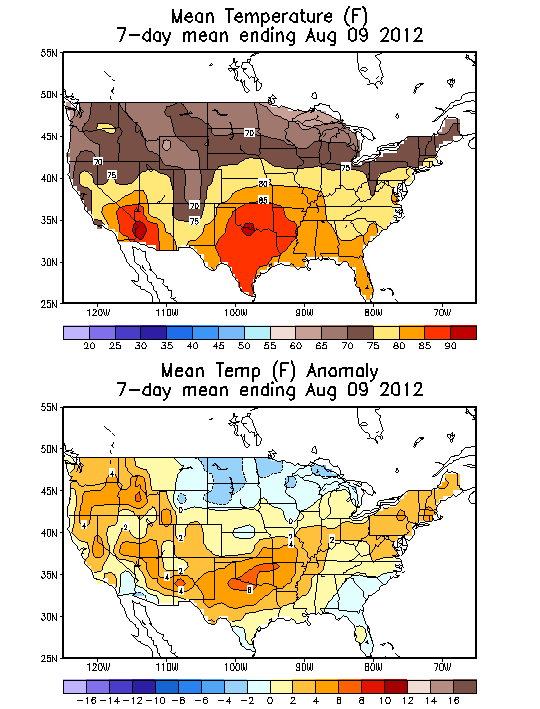
Source: NOAA/National Weather Service
Deviation between average and normal (°F)
7-Day Mean ending Aug 09, 2012

Source: NOAA/National Weather Service
Monthly dry shale gas production
billion cubic feet per day
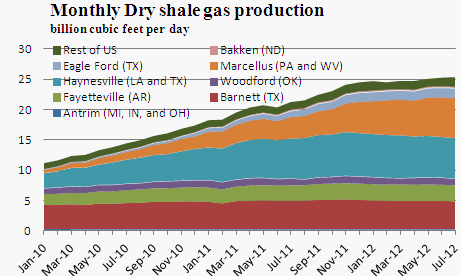
Source: Lippman Consulting, Inc. Gross withdrawal estimates are as of July 2012 and converted to dry production estimates with EIA-calculated average.
